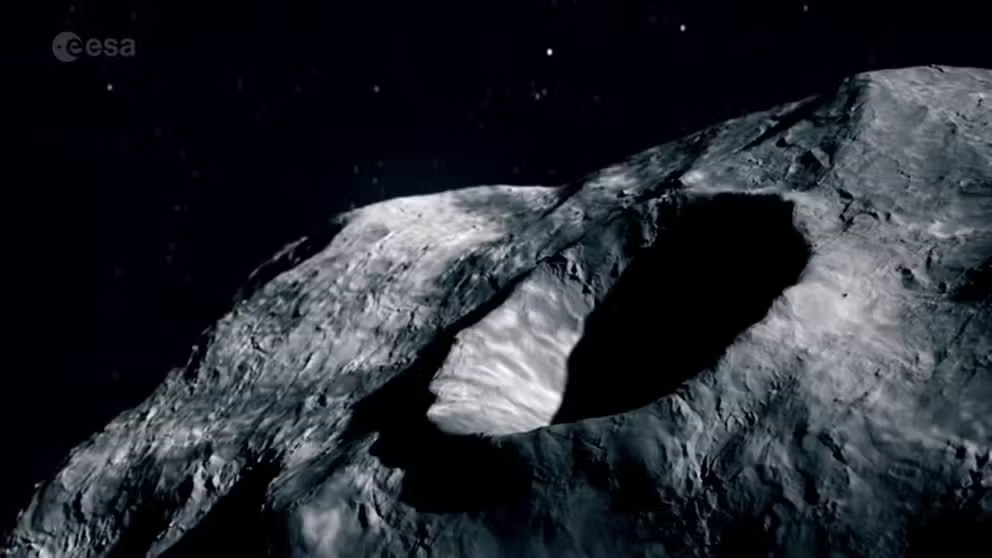7 things to know about NASA’s DART mission
The spacecraft will slam into an asteroid at 15,000 mph to test out an Earth defense plan.

Illustration of NASA’s DART spacecraft and the Italian Space Agency’s (ASI) LICIACube prior to impact at the Didymos binary system. Credit: NASA/Johns Hopkins APL/Steve Gribben
(NASA)
SpaceX will launch a NASA spacecraft next week designed to test out a planetary-defense method that could one day save Earth.
NASA plans to use the Double Asteroid Redirect, or DART, spacecraft as a battering ram to crash into a near-Earth asteroid and see if the kinetic energy can change its direction by a tiny amount. It’s the first mission of its kind and part of an international collaboration to protect Earth from asteroid impacts.
A SpaceX Falcon 9 rocket will launch DART from Vandenberg Air Force Base in California. The current launch opens at 10:21 p.m. PT on Nov. 23 (1:21 a.m. ET on Nov. 24).
After launch, the spacecraft will head to its final destination: the asteroid Didymos and its smaller orbiting asteroid Dimorphos.
The spacecraft will catch up to the asteroid in September or October 2022 and complete the test soon after.
Read on to catch up on the details of the mission before liftoff.
Mission objective
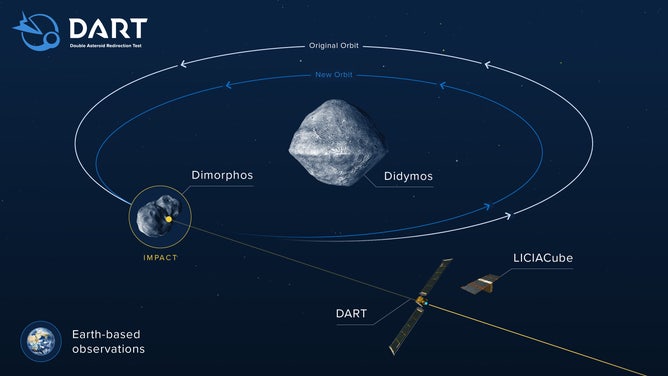
A rendering of the DART spacecraft and the asteroid pair, Didymos and Dimorphos.
(NASA)
If DART hits Dimorphos at 15,000 mph as planned, this is the best way to test the kinetic impactor Earth defense theory.
"The point of a kinetic impactor is you ram your spacecraft into the asteroid you're worried about, and then you change its orbit around the Sun by doing that," Johns Hopkins Applied Physics Laboratory Planetary astronomer Andy Rivkin said.
LEARN: Why 'Armageddon' plot is not Earth's best defense from asteroids
DART won't change the orbit of Didymos. It aims to change the speed of the moonlet, Dimorphos. This is because scientists using ground-based telescopes and later another spacecraft will see if it works.
Asteroids move around the Sun at a speed of about 20 miles a second. If a kinetic impactor method were used to change its orbit, engineers would only want to alter that by maybe an inch or two a second, a tiny amount, Rivkin explained.
That's why Didymos and its moonlet Dimorphos make a perfect practice target. The tiny asteroid orbiting Didymos moves about a foot per second which is much easier to measure than 20 miles per second.
If this works, the idea is to apply the same technique to larger asteroids. Until this mission, scientists could only simulate such an impact in a lab. DART will give them data to help solidify this defense plan.
Meet DART
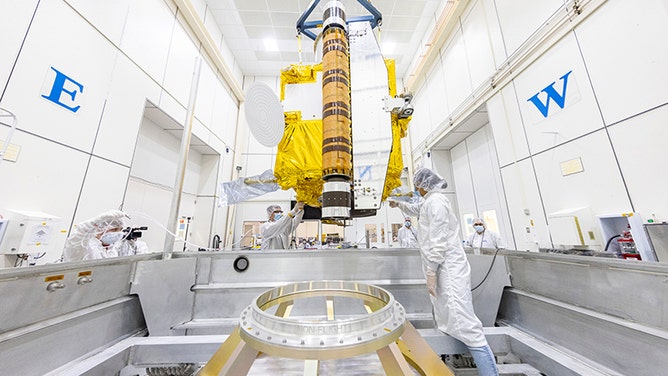
Inside a clean room at Johns Hopkins APL, the DART spacecraft was moved into a specialized shipping container that headed across the country to Vandenberg Space Force Base near Lompoc, California, where DART is scheduled to launch from in November. Credit: Johns Hopkins APL/Ed Whitman
(Johns Hopkins APL)
The $330 million mission consists of one spacecraft and a CubeSat.
DART is about the size of a vending machine with a camera as the only instrument on board. The Didymos Reconnaissance and Asteroid Camera for Optical navigation, known as DRACO, will capture images of Didymos and Dimorphos and be used to help the spacecraft autonomously navigate. DART uses a navigation system called the Small-body Maneuvering Autonomous Real-Time Navigation or SMART Nav to guide itself.
Its primary source of power is the sun. The spacecraft has Roll-Out Solar Arrays that deploy after it's in orbit, expanding the whole spacecraft to about the length of a school bus.
Rivkin said the most crucial part of DART is its mass used to smash into Dimorphos at 15,000 mph.
About LICIACube
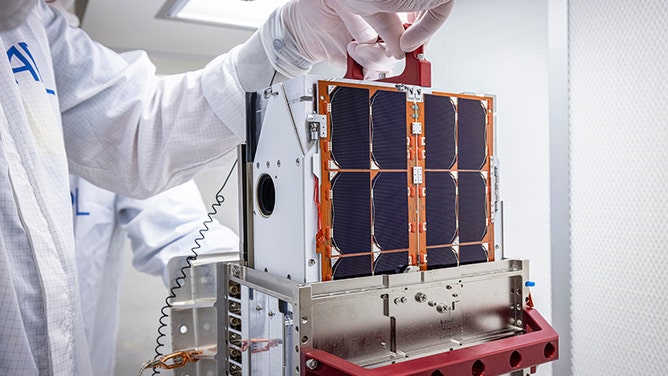
DART team engineers lift and inspect the LICIACube CubeSat after it arrived at Johns Hopkins APL in August. Credit: Johns Hopkins APL/Ed Whitman
(Johns Hopkins APL)
The DART spacecraft also carries LICIACube, a tiny satellite by the Italian Space Agency that will take pictures after DART's demise.
LICIACUbe is about the size of a cereal box and has two cameras nicknamed after "Star Wars" characters: LUKE (LICIACube Unit Key Explorer) and LEIA (LICIACube Explorer Imaging for Asteroid).
The CubeSat will separate from DART 10 days before the larger spacecraft rams into the asteroid.
LICIACube will then fly past Dimorphos around three minutes after the DART impact to capture images of the impact's effects.
"For a first mission, it's really something," said Andy Cheng, an APL planetary scientist and lead investigator of DART. "Without LICIACube, there would be no observation of the ejecta cloud."
These asteroids won’t hurt Earth

Infographic showing the sizes of the two asteroids in the Didymos system relative to some objects on Earth. Credit: NASA/Johns Hopkins APL
(NASA/Johns Hopkins APL)
While Didymos and Dimorphos are not threats to Earth, NASA selected the binary asteroids because the space rocks are relatively close to Earth. Ground-based telescopes can observe the pair, including tracking any change after DART completes its mission.
DART Coordination Lead Nancy Chabot said the team also chose the asteroid duo because it is common in the near-Earth object population.
"It's actually 4.5 billion years old. It formed before the planets formed. It's like the leftovers of planets formation. So that actually makes this asteroid system a really good test in order to do this as well," Chabot said.
This is why DART makes a good test that could be applied to other near-Earth asteroids.
Didymos is about 780-meters, and Dimorphos is 160-meters.
Rivkin also pointed out that when DART his Dimorphos, it won't create a problem for Earth.
"Whatever we do to it is not going to make it a threat to the Earth," he said. "We're trying to make a 10-foot putt, right? And, you know, hopefully, we'll make the putt. Maybe we'll miss the putt, but we're not going to end up giving you a 200-yard drive as a result. That's not how that's going to work. So we're not going to cause a problem."
Next up: HERA
Queen guitarist and astrophysicist Brian May explains the HERA mission
The European Space Agency spacecraft HERA will observe the impact left behind from NASA's DART spacecraft.
A European Space Agency mission called HERA will launch in 2024 and get a close-up look at DART's impact site.
HERA will carry a set of CubeSats to go in for a closer look at Didymos and Dimorphos.
According to the ESA, CubeSat Milani will make spectral surface observations, while Juventas will take the first-ever radar soundings within an asteroid.
MORE: NASA slamming a spacecraft into an asteroid is part of an international plan to save Earth
Why Earth needs a planetary defense plan
The critical part of NASA’s Planetary Defense effort is the Near-Earth Object (NEO) Observations Program, designed to find, characterize and track at least 90% of NEOs at least 140 meters. These are about the size of a small football field, according to NASA.
About 27,000 near-Earth asteroids have been identified, or about 40%.
An object of this size would cause widespread devastation wiping out a massive area but likely would not cause a mass extinction event like what happened to the dinosaurs. For context, the last mass extinction event 66 million years ago was caused by an asteroid about 7-miles wide. The asteroid left a 125-mile-wide impact crater off the coast of Mexico.
That crater is still being studied today, and researchers are closer to determining where the asteroid originated from and what materials it contained. These are all important clues to know when the next hit could happen.
While there are no known asteroids 140 meters or larger with a significant chance of hitting Earth in at least 100 years, it's imperative to understand how to deflect one when the time comes.
NASA Planetary Defense Officer Lindsey Johnson said the best time to deflect an asteroid is as far away from Earth as we can.
"The strategy is to find these objects not only years but decades before they're any kind of an impact hazard to the Earth. So we have time to characterize them first and know where they're going to be headed," Johnson said.
If researchers can identify the asteroid and determine its size and composition, they will know the best method to change its orbit.
"The further away in space, years before the impact, the less force it takes to change the orbit enough that it will be a miss instead of a hit," Johnson said.
Asteroid missions are all the rage right now, for good reason
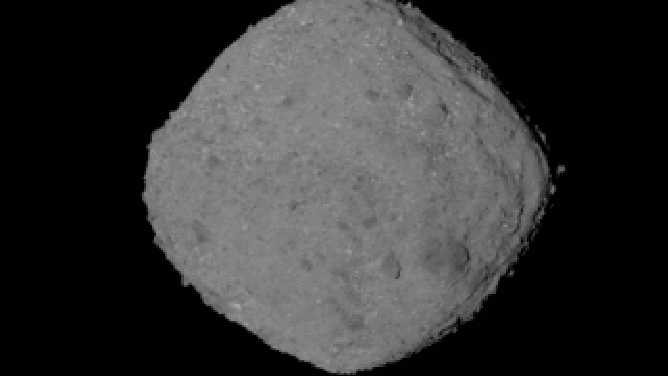
This set of images shows the asteroid Bennu rotating for one full revolution. Over a 4-hour and 11-minute period on Nov. 2, the PolyCam camera on NASA’s OSIRIS-REx spacecraft acquired a 2.5-millisecond image for every 10 degrees of the asteroid’s rotation. (Image: NASA/Goddard/University of Arizona)
(NASA/Goddard/University of Arizona)
In the last decade, NASA, the Japanese Space Agency, and the European Space Agency have conducted robotic missions to different asteroids, and more are planned in the next ten years. Japan has collected two samples from asteroids, and NASA's OSIRIS-REx spacecraft is bringing home a sample of the asteroid Bennu in a first for the U.S.
These missions have proven that spacecraft can perform precise navigation around a rock hurtling through space at 20 miles per second.
Earlier this year, NASA's Lucy spacecraft was launched to study the Trojan asteroids associated with Jupiter. Next year, the agency will launch another mission known as Psyche that will explore a unique asteroid made of metals.
Asteroids are essentially fossils of the solar system. These primitive bodies hold vital clues to deciphering how the planets formed and how we got here.
